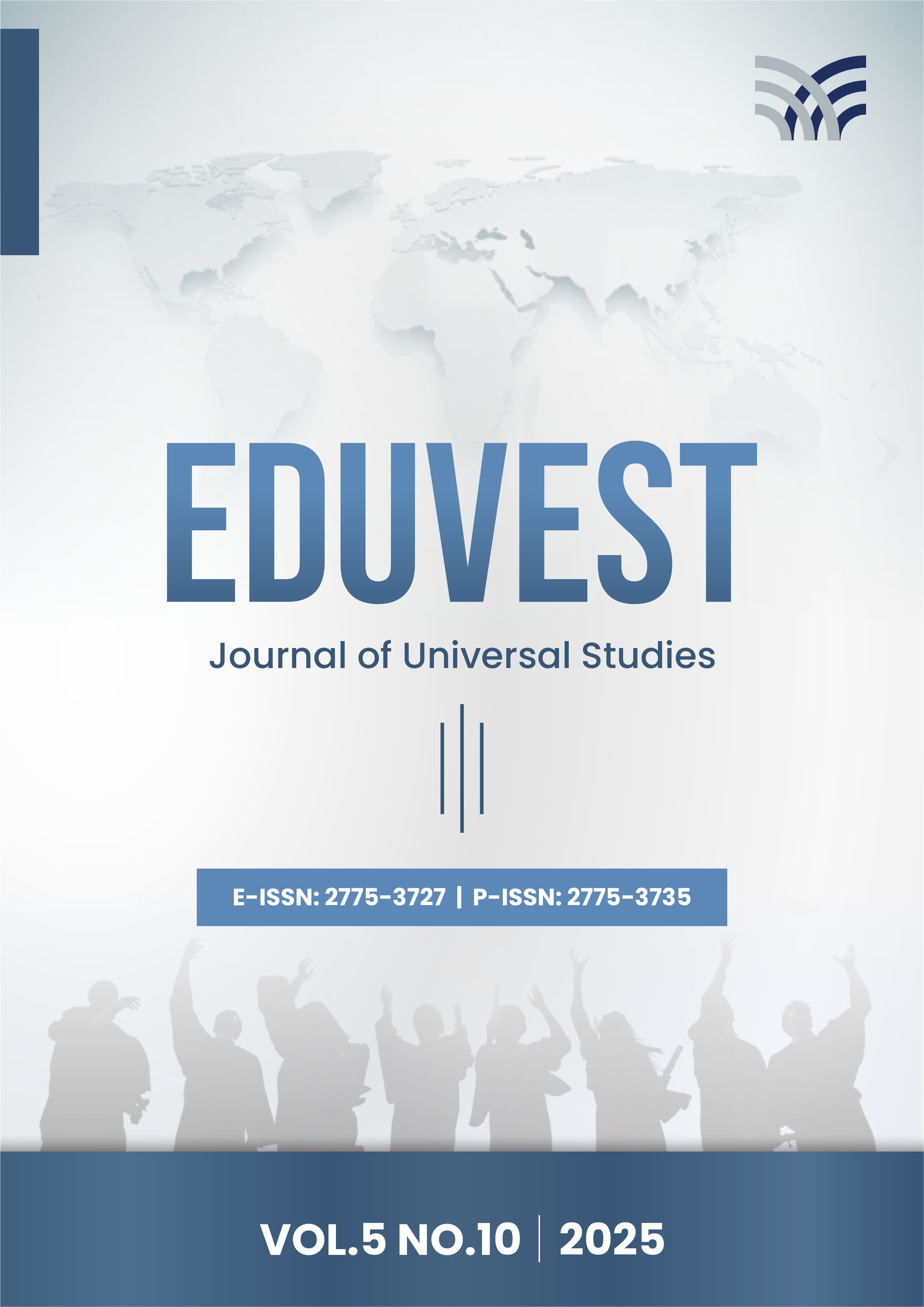Strengthening Fraud Prevention Through the Three Lines of Defense in Public Infrastructure Oversight
DOI:
https://doi.org/10.59188/eduvest.v5i10.51499Keywords:
Fraud Prevention, Three Lines of Defense, Ethnomethodology, Public Sector Oversight, Internal Control EffectivenessAbstract
This study examines the effectiveness of fraud prevention in the Directorate General of Infrastructure Financing at the Indonesian Ministry of Public Works using the Three Lines of Defense model. Employing a qualitative ethnomethodological approach, the research explores how actors in each line—the operational units, internal compliance, and internal auditors—perceive and perform their roles in everyday practices. Data were collected through in-depth interviews and focus group discussions with nine informants, representing each line equally. The analysis reveals that formal oversight structures are often interpreted and enacted through informal social norms, with coordination heavily reliant on interpersonal trust and ad hoc communication. The study identifies key challenges, including overlapping responsibilities, limited authority of the second line, and a lack of integrated procedures. Moreover, the findings highlight that the perception of fraud and internal control is shaped by collective social knowledge, which does not always align with institutional policies. This gap between formal frameworks and practical implementation undermines the overall effectiveness of fraud prevention mechanisms. The research suggests that aligning policy and practice requires developing cross-line standard operating procedures, empowering the second line structurally, fostering a culture of risk awareness, and institutionalizing collaborative forums to ensure coherent coordination. These strategies aim to reinforce not only structural integrity but also the social and cultural dimensions of internal oversight.
References
Ali, F., Handro, A., Caltex Riau, P., & Umbansari No, J. (2022). Accountants and auditors' perceptions of technology and attitude of integrity in preventing fraud. Jurnal Akuntansi, 13(2).
Anandya, D., & Ramadhana, K. (2024). Laporan hasil pemantauan tren korupsi tahun 2023. Indonesia Corruption Watch, 1–51.
Ayulestari, N. (2019). Surprise audit dalam pencegahan fraud: Studi etnometodologi pada kasus perusahaan X [Unpublished manuscript]. Universitas Muhammadiyah Surakarta. http://eprints.ums.ac.id/id/eprint/80514/Naskah%20Publikasi%20Ilmiah.pdf
Aziz, F. L. A., & Othman, I. W. (2021). Internal auditors' perception on the efficacy of fraud prevention and detection in the public sector. Universal Journal of Accounting and Finance, 9(4), 764–772. https://doi.org/10.13189/ujaf.2021.090422
Badan Pemeriksa Keuangan Republik Indonesia. (n.d.). BPK ungkap temuan penting dalam LHP DTT penyelenggaraan jalan tol Kementerian PUPR. Retrieved February 21, 2025, from https://www.bpk.go.id/news/bpk-ungkap-temuan-penting-dalam-lhp-dtt-penyelenggaraan-jalan-tol-kementerian-pupr
Bougie, R., & Sekaran, U. (2019). Research methods for business: A skill building approach (8th ed.). John Wiley & Sons.
Cressey, D. R. (1953). Other people's money: A study in the social psychology of embezzlement. Free Press.
Creswell, J. W. (2023). Research design: Qualitative, quantitative, and mixed methods approaches (6th ed.). SAGE Publications.
Detik.com. (n.d.). Ketua pokja jadi tersangka baru korupsi proyek IPAL Makassar Rp 7,9 M. Retrieved January 20, 2025, from https://www.detik.com/sulsel/makassar/d-7612968/ketua-pokja-jadi-tersangka-baru-korupsi-proyek-ipal-makassar-rp-7-9-m/amp
Glory, G. M., Lazaro, A. M., & Alexis, N. (2022). Effectiveness of fraud prevention and detection methods in the public sector in Tanzania. Journal of Accounting and Taxation, 14(1), 30–36. https://doi.org/10.5897/jat2021.0496
Kamayanti, A. (2020). Metodologi penelitian kualitatif akuntansi: Pengantar religiositas keilmuan (Ed. 2, A. D. Mulawarman, Ed.). Penerbit Peneleh.
Kementerian Pekerjaan Umum dan Perumahan Rakyat. (2024). Best practices of public sector risk management: Studi kasus Kementerian PUPR professional recognition program qualified government internal auditor.
Komisi Pemberantasan Korupsi. (2025). Mengkaji untuk membasmi. https://cms.kpk.go.id/storage/6588/MENGKAJI-UNTUK-MEMBASMI_KAJIAN-MONITORING-2020-2024-ISBN.pdf
Mubarokah, N. L., & Rahayu, S. I. (2023). Determining factors for fraud prevention. Journal of Accounting, Management, and Economics Research (JAMER), 2(2), 93–104. https://doi.org/10.33476/jamer.v2i2.152
Othman, R., Aris, N. A., Mardziyah, A., Zainan, N., & Amin, N. M. (2015). Fraud detection and prevention methods in the Malaysian public sector: Accountants' and internal auditors' perceptions. Procedia Economics and Finance, 28, 59–67. https://doi.org/10.1016/s2212-5671(15)01082-5
Samuel, O. A. (2022). Internal audit efficiency and fraud prevention: Empirical study of listed manufacturing companies in Nigeria. International Journal of Management and Economics Invention, 8(9), 5338–5357. https://doi.org/10.47191/ijmei/v8i9.04
Stake, R. E. (1995). The art of case study research. SAGE Publications.
Syahlan, K., Febriani, F., Sayyid, M., Widiyawati, W., & A'alia, P. S. (2022). Peran three lines model dalam mendeteksi fraud hexagon model berdasarkan sudut pandang mahasiswa akuntansi. E-Prosiding Akuntansi, 3(1), 37–50. https://doi.org/10.31326/.V3I1.1179
Tanaka, S., & Hayashi, S. (2016). Collusion between public procurers and suppliers in the context of Japan's public procurement: The role of the risks of "unsuccessful procurement." Journal of Public Procurement, 16(3), 291–311. https://doi.org/10.1108/JOPP-16-03-2016-B003
The Institute of Internal Auditors. (2020). The IIA's three lines model: An update of the three lines of defense. https://www.theiia.org/en/content/position-papers/2020/the-iias-three-lines-model-an-update-of-the-three-lines-of-defense/
Velardo, S., & Elliott, S. (2021). Co-interviewing in qualitative social research: Prospects, merits and considerations. International Journal of Qualitative Methods, 20, 1–14. https://doi.org/10.1177/16094069211054920
Downloads
Published
How to Cite
Issue
Section
License
Copyright (c) 2025 Deka Bayu Dirgantara, Arum Prastiwi, Virginia Nur Rahmanti

This work is licensed under a Creative Commons Attribution-ShareAlike 4.0 International License.











